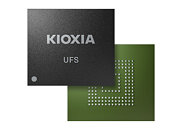
KIOXIA America Showcases Breakthrough Flash Storage Solutions at Dell Technologies World
Next week at Dell Technologies World, KIOXIA America, Inc. will be on hand to demonstrate how its innovative solid state drives (SSDs) are accelerating customer application performance and enabling product breakthroughs. From SSDs designed with PCIe 5.0 technology that boost power and performance to the industry's first lineup of Enterprise and Datacenter Standard Form Factor (EDSFF) E3.S SSDs, best in class drives from KIOXIA are used in a number of Dell product lines.
KIOXIA, the inventor of NAND flash, sits at the forefront of flash storage and SSD innovation. Achievements such as the introduction of 3D flash memory, XL-FLASH storage class memory, and new form factors and interfaces underscore the contributions the company has made toward enabling next-gen applications - and transforming the digital world.
KIOXIA, the inventor of NAND flash, sits at the forefront of flash storage and SSD innovation. Achievements such as the introduction of 3D flash memory, XL-FLASH storage class memory, and new form factors and interfaces underscore the contributions the company has made toward enabling next-gen applications - and transforming the digital world.






























